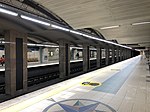D. Maria II National Theatre
National monuments in Lisbon DistrictNational theatresNeoclassical architecture in PortugalTheatres in Lisbon

The Queen Maria II National Theatre (Portuguese: Teatro Nacional D. Maria II) is a theatre in Lisbon, Portugal. The historic theatre is one of the most prestigious Portuguese venues and is located in the Rossio square, in the centre of the city.
Excerpt from the Wikipedia article D. Maria II National Theatre (License: CC BY-SA 3.0, Authors, Images).D. Maria II National Theatre
Praça Dom Pedro IV, Lisbon Santa Maria Maior (Santa Maria Maior)
Geographical coordinates (GPS) Address External links Nearby Places Show on map
Geographical coordinates (GPS)
| Latitude | Longitude |
|---|---|
| N 38.7148 ° | E -9.1398 ° |
Address
Teatro Nacional Dona Maria II (Teatro Nacional de Almeida Garrett)
Praça Dom Pedro IV 1
1100-201 Lisbon, Santa Maria Maior (Santa Maria Maior)
Portugal
Open on Google Maps









